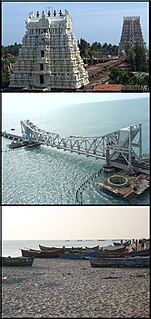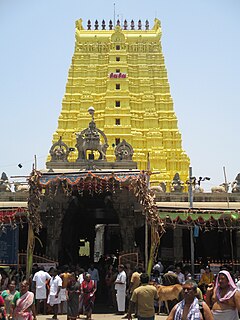The following outline is provided as an overview of and topical guide to Hinduism:

Rameswaram is a municipality in the Ramanathapuram district of the Indian state of Tamil Nadu. It is on Pamban Island separated from mainland India by the Pamban channel and is about 40 kilometres from Mannar Island, Sri Lanka. It is in the Gulf of Mannar, at the tip of the Indian peninsula. Pamban Island, also known as Rameswaram Island, is connected to mainland India by the Pamban Bridge. Rameswaram is the terminus of the railway line from Chennai and Madurai. Together with Varanasi, it is considered to be one of the holiest places in India to Hindus and is part of the Char Dham pilgrimage.

Kambar or Kavichakravarthy Kamban was a medieval Tamil poet and the author of the Ramavataram, popularly known as Kambaramayanam, the Tamil version of the epic Ramayana. Kambar also authored other literary works in Tamil, such as Thirukkai Vazhakkam, Erezhupathu, Silaiyezhupathu, Kangai Puranam, Sadagopar Anthathi and Saraswati Anthathi.

The Parthasarathy Temple is a 6th-century Hindu Vaishnavite temple dedicated to Vishnu in Chennai, India. Located in the neighbourhood of Thiruvallikeni, the temple is glorified in the Divya Prabandha, the early medieval Tamil literature canon of the Alvar saints from the 6th to 9th centuries CE and is classified as among the 108 Divya Desams dedicated to Vishnu. The name 'Parthasarathy' means the 'charioteer of Arjuna', referring to Krishna's role as a charioteer to Arjuna in the epic Mahabaratha.
Tiruvaikuntam is a panchayat town in Thoothukudi district in the Indian state of Tamil Nadu. It is located on the banks of the river Thamirabarani.
West Mambalam is a residential and commercial area in Chennai, India. It is known for its shops, bazaars and Hindu temples. It is bounded by Kodambakkam to the north and Saidapet to the south. T. Nagar and Nandanam stretch all along its eastern frontiers while Ashok Nagar lies to its west. The Ayodhya Mandapam is an important landmark.
Ashok Nagar is a residential locality situated at the southern part of Chennai, Tamil Nadu, India. It was established in 1964. At the heart of this colony, stands the Ashok Pillar. This four lion head stump, resembles the one erected by king Ashoka during the 3rd century BCE at Sanchi.

Harikatha, also known as Harikatha Kaalakshepam in Telugu and Tamil, is a form of Hindu traditional discourse in which the storyteller explores a traditional theme, usually the life of a saint or a story from an Indian epic. The person telling the story through songs, music and narration is called a Haridasa.

Ramanathaswamy Temple is a Hindu temple dedicated to the god Shiva located on Rameswaram island in the state of Tamil Nadu, India. It is also one of the twelve Jyotirlinga temples. It is one of the 275 Paadal Petra Sthalams, where three of the most revered Nayanars, Appar, Sundarar and Tirugnana Sambandar, have glorified the temple with their songs. The temple was expanded during the 12th century by the Pandya Dynasty, and its principal shrine’s sanctum was renovated by Jeyaveera Cinkaiariyan and his successor Gunaveera Cinkaiariyan, monarchs of the Jaffna kingdom. The temple has the longest corridor among all Hindu temples in India. It was built by King Muthuramalinga Sethupathiy. The temple, located in Rameswaram, is considered a holy pilgrimage site for Shaivites, Vaishnavites and Smarthas. Mythological accounts depict the presiding deity, the Lingam of Ramanathaswamy (Shiva), as having been established and worshiped by Rama, before he crossed his bridge to the present-day island of Sri Lanka.

Vaikhanasa is one of the principal traditions of Hinduism and primarily worships Vishnu as the Supreme God. The followers are mainly Brahmins of Krishna Yajurveda Taittiriya Shakha and Vaikhanasa Kalpasutra. The name Vaikhānasa stands for the followers and the fundamental philosophy itself with the name derived from founder, Sage Sri Vikhanasa. It is principally monotheistic in its philosophy, whilst also incorporating elements which could be described as being panentheistic. Vaikhanasa principle focuses on rituals and worship of Lord Vishnu rather than the philosophy of Uttara Mimamsa, unlike Vaishnavism, the larger and more prevalent form on Vishnu worship.

Rama, Ram, Raman or Ramar, also known as Ramachandra, is a major deity in Hinduism. He is the seventh and one of the most popular avatars of Vishnu. In Rama-centric traditions of Hinduism, he is considered the Supreme Being.
Sri Sarabha Sastri (1872–1904) was an Indian venu flute player, known as the first great Brahmin flutist. He brought the flute to the mainstream Indian Carnatic concert stage – until then, it was almost exclusively a folk instrument. To Sastri goes the credit of promoting the flute to the status of a primary concert instrument from being a mere 'second fiddle' to dance.

The Adi Jagannatha Temple is a South Indian Hindu temple in Thiruppullani, a village in the outskirts of Ramanathapuram in the South Indian state of Tamil Nadu, is dedicated to the Hindu god Vishnu. It is believed that Rama used grass ('pul' in Tamil as a pillow to sleep and hence the village attained the name Thiruppullani. Constructed in the Dravidian style of architecture, the temple is glorified in the Divya Prabandha, the early medieval Tamil canon of the Azhwar saints from the 6th–9th centuries CE. It is one of the 108 Divyadesam dedicated to Vishnu, who is worshipped as Adi Jagannatha and his consort Lakshmi as Padmasini.

The Anjaneya Temple at Nanganallur, Chennai is a Hindu temple dedicated to the god Hanuman. The principal idol of Hanuman is 32-feet tall and sculpted from a single piece of granite, which the second tallest Hanuman after Panchavatee near Puducherry.
Mudikondan Kothandaramar Temple is a Hindu temple located in the Tiruvarur district of Tamil Nadu, India, dedicated to Lord Rama, the seventh avatar of Lord Vishnu. The town of Mudikondan is located at a distance of 20 kilometres from Mayiladuthurai and 15 kilometres from Thiruvarur in the Nannilam taluk.
Sethanipuram is a village situated in Thiruvarur District in Tamil Nadu, India. It was part of Tanjore District under the British Raj.
KKD Nagar, also known as Kaviyarasu Kannadasan Nagar named after the Tamil poet Kannadasan, is mainly a sub-residential locality of Kodungaiyur in the northern part of the metropolitan city of Chennai, Tamil Nadu state, India.

Soundararajaperumal Temple is a temple dedicated to Hindu god Vishnu, located in Thadikombu, a village near Dindigul in the South Indian state of Tamil Nadu. Constructed in Dravidian style of architecture, the temple is believed to have been built by Achyuta Deva Raya during the 16th century AD. Vishnu is worshiped as Soundararaja Perumal and his consort Lakshmi as Soundaravalli.

Sri Vasavi Kanyaka Parameswari Charitra is a 2014 Telugu, mythological film directed by Sripada Ramachandra Rao. The film stars Ramya Krishna, Suman, Ranganath, Sai Kiran, Sandeepthi and Shobha in important roles.











